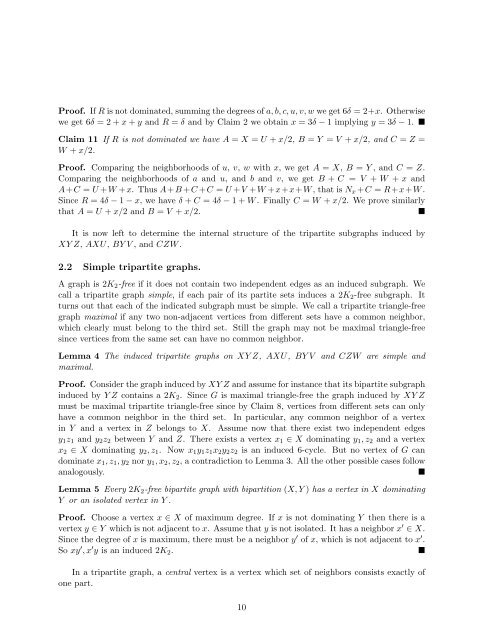Dense triangle-free graphs are four-colorable: A solution to ... - Lirmm
Dense triangle-free graphs are four-colorable: A solution to ... - Lirmm
Dense triangle-free graphs are four-colorable: A solution to ... - Lirmm
Create successful ePaper yourself
Turn your PDF publications into a flip-book with our unique Google optimized e-Paper software.
Proof. If R is not dominated, summing the degrees of a, b, c, u, v, w we get 6δ = 2+x. Otherwise<br />
we get 6δ = 2 + x + y and R = δ and by Claim 2 we obtain x = 3δ − 1 implying y = 3δ − 1. <br />
Claim 11 If R is not dominated we have A = X = U + x/2, B = Y = V + x/2, and C = Z =<br />
W + x/2.<br />
Proof. Comparing the neighborhoods of u, v, w with x, we get A = X, B = Y , and C = Z.<br />
Comparing the neighborhoods of a and u, and b and v, we get B + C = V + W + x and<br />
A+C = U +W +x. Thus A+B +C +C = U +V +W +x+x+W , that is Nx +C = R+x+W .<br />
Since R = 4δ − 1 − x, we have δ + C = 4δ − 1 + W . Finally C = W + x/2. We prove similarly<br />
that A = U + x/2 and B = V + x/2. <br />
It is now left <strong>to</strong> determine the internal structure of the tripartite sub<strong>graphs</strong> induced by<br />
XY Z, AXU, BY V , and CZW .<br />
2.2 Simple tripartite <strong>graphs</strong>.<br />
A graph is 2K2-<strong>free</strong> if it does not contain two independent edges as an induced subgraph. We<br />
call a tripartite graph simple, if each pair of its partite sets induces a 2K2-<strong>free</strong> subgraph. It<br />
turns out that each of the indicated subgraph must be simple. We call a tripartite <strong>triangle</strong>-<strong>free</strong><br />
graph maximal if any two non-adjacent vertices from different sets have a common neighbor,<br />
which clearly must belong <strong>to</strong> the third set. Still the graph may not be maximal <strong>triangle</strong>-<strong>free</strong><br />
since vertices from the same set can have no common neighbor.<br />
Lemma 4 The induced tripartite <strong>graphs</strong> on XY Z, AXU, BY V and CZW <strong>are</strong> simple and<br />
maximal.<br />
Proof. Consider the graph induced by XY Z and assume for instance that its bipartite subgraph<br />
induced by Y Z contains a 2K2. Since G is maximal <strong>triangle</strong>-<strong>free</strong> the graph induced by XY Z<br />
must be maximal tripartite <strong>triangle</strong>-<strong>free</strong> since by Claim 8, vertices from different sets can only<br />
have a common neighbor in the third set. In particular, any common neighbor of a vertex<br />
in Y and a vertex in Z belongs <strong>to</strong> X. Assume now that there exist two independent edges<br />
y1z1 and y2z2 between Y and Z. There exists a vertex x1 ∈ X dominating y1, z2 and a vertex<br />
x2 ∈ X dominating y2, z1. Now x1y1z1x2y2z2 is an induced 6-cycle. But no vertex of G can<br />
dominate x1, z1, y2 nor y1, x2, z2, a contradiction <strong>to</strong> Lemma 3. All the other possible cases follow<br />
analogously. <br />
Lemma 5 Every 2K2-<strong>free</strong> bipartite graph with bipartition (X, Y ) has a vertex in X dominating<br />
Y or an isolated vertex in Y .<br />
Proof. Choose a vertex x ∈ X of maximum degree. If x is not dominating Y then there is a<br />
vertex y ∈ Y which is not adjacent <strong>to</strong> x. Assume that y is not isolated. It has a neighbor x ′ ∈ X.<br />
Since the degree of x is maximum, there must be a neighbor y ′ of x, which is not adjacent <strong>to</strong> x ′ .<br />
So xy ′ , x ′ y is an induced 2K2. <br />
In a tripartite graph, a central vertex is a vertex which set of neighbors consists exactly of<br />
one part.<br />
10

















